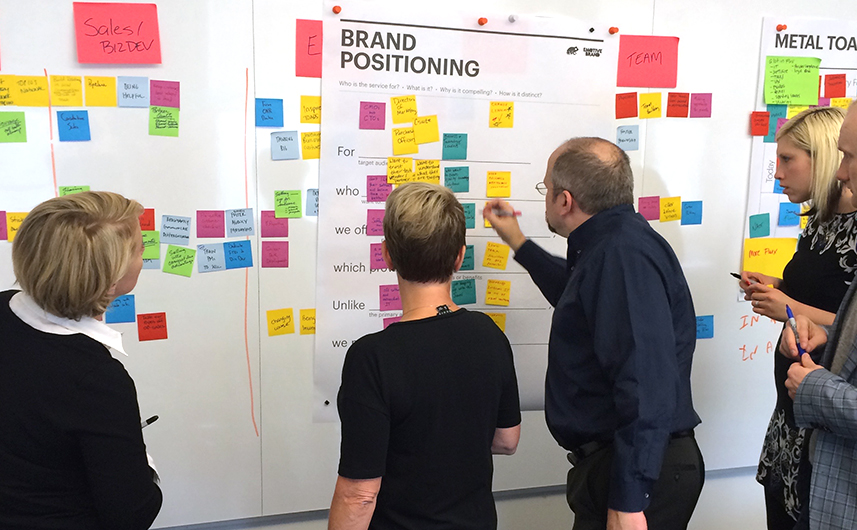What Got You Here
Sometimes it’s hard to recognize that it’s time for a brand refresh. Why embark on a brand refresh if your business is successfully growing? Many high-growth companies grow organically, without any strategic direction. Things takeoff. Your team expands. New offices open. Your product line multiplies. And growth mode may happen without making plans for how the brand will accommodate and flex as the business develops.
At these times, decisions are often made that help an internal team manage change. In many cases, this means that some of the key brand components end up holding greater meaning for those inside of the company, but lack meaning for other key audiences – prospects, customers, and recruits – who also matter to the brand’s success.
The warning signs of a solely internal-facing brand are plenty: internal names for your product, add-on brands, or a website that has been pieced together, mirroring the evolution of the company. These common indicators show that important audiences have been forgotten. If this sounds familiar, your brand needs to start looking outside itself.
Forgetting Who’s Outside
The problem with an internal-facing brand is that the brand isn’t always clear or powerful to outsiders. The purpose of an impactful brand is to connect meaningfully with all the people who matter to your business – inside and out. So if a brand makes sense to your team, but isn’t as easily understood by external audiences, your brand loses impact, and as a result, business eventually stagnates.
Sometimes all the effort that went into scaling your business becomes your brand strategy – making it very hard for outsiders to understand who you are, what you do, and why you matter. And when the people crucial to your business’s success don’t understand your brand, your business can easily fall behind the competition, risk becoming irrelevant and may even lack the future support needed to move your brand and business forward.
Time for a Brand Refresh
Consider these aspects of your strategy to refresh your brand and position your business for continued future growth.
1. Brand Architecture
For many high-growth companies, add-on brands have rendered your architecture irrelevant. Do you have one brand or many brands? A branded house? Or a house of brands? How do all of your products fit into the structure of your brand? Evaluate how all the different products, business units, and pieces of your brand fit together. Don’t let organic growth lead the way. Develop your brand architecture to help people understand your business, products, and services. Enable that architecture to work for today and accommodate for tomorrow.
2. Category Reframing
Your brand needs to fit into the framework of a brand category that people understand and relate to in order to really ‘get’ your brand. Companies that have experienced organic growth oftentimes outgrow their original category without realizing it. As such, many high-growth company will start in one category and need to shift into another over time. This shift might be necessitated by the advancement of products, the market, and/or new category. Choosing the right category or defining a new one is critical to positioning your brand in a way that frames your value and makes it relevant to your customers. We like to think of category development as a process that helps clarify and shape the perceptions, feelings, and attitudes about your brand. Think about articulating the right metaphor that will make it easy for people to find meaning in your brand.
3. Positioning
Knowing how you want your brand represented, enforced, and reinforced is part of developing your positioning. A strong and meaningful positioning can enhance what your brand does, how it differs from your competitors, and why it’s better than any alternative in the market. Ensuring you have the right positioning strategy is critical to building your business.
4. Target Audience
Who is important to your brand? Who do you sell to? Who are your most important brand champions? Who are the key influencers? These are all important questions to answer during a brand refresh. For high-growth companies, the people who were important to your brand when you started have probably evolved. So take a critical eye and focus on understanding precisely who your target audience is, why you matter to them, what are they looking to solve, and how can you create messaging to speaks to their needs and desires.
5. Your Why
It’s critical to make sure you lead with ‘why’ during a brand refresh. Most likely the success of your business and its growth is the result of your purpose, or reason for being. Formalizing your purpose into a brand promise will help your growing team get aligned internally around why you matter. Everyone can get on board the same boat and row towards the same higher purpose. And when you align everyone internally and drive them towards that purpose, the people on the outside will feel your why as well. A brand is a way of bringing your purpose to life, so focus on it and how you can make people believe in your brand.
6. The Competition
In order to differentiate yourself and offer unique value to your audiences, you have to know your competition – inside and out. Who you were competing with when you started businesses has most likely entirely shifted, especially in the fast-paced business world we work in today. Map your current brand against the competition and shift accordingly.
7. Corporate Narrative
Investing in developing a corporate narrative helps everyone understand who you are, what you do, why you matter, and what the future holds for your business. If everyone internally has insight into this, it helps the external storytelling become clear and consistent. Your corporate narrative should help tell the story of your brand in an honest, meaningful, and emotive way.
8. Creative Assets
Oftentimes, making your brand more clear, powerful, and meaningful to key audiences means refreshing your visual identity (and from there, your website). Ensure your identity represents who you are and why you matter. When looking to revamp your website, hire experts. Make sure your navigation clearly reflects your brand strategy and make sure your value proposition is clear and understandable to website visitors. There are many decisions to be made when redesigning a website, so use your newly refreshed brand strategy to guide these decisions. A strategically lead redesign is key to having a well-designed user experience.
A Brand Refresh = More Meaningful, Competitive, Successful Business
Taking the time to invest in your brand will bring tangible positive results to your bottom line.
In order to hold greater meaning in the hearts and minds of the people who are most important to your business, strongly position your brand and focus on meaningfully articulating your value.
By getting everyone around the table internally, with sales and marketing brought together, your sales cycle quickens, your business becomes better positioned for success, your recruitment efforts prove more successful, and your brand helps fuel a competitive and thriving business.
Refresh your brand and bring its purpose to life for both inward- and outward-facing audiences in order to stay ahead and continue to grow. Your business depends on it.
Emotive Brand is a San Francisco brand strategy agency.








